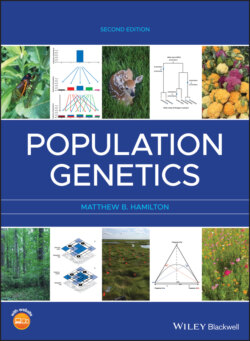Читать книгу Population Genetics - Matthew B. Hamilton - Страница 54
End‐of‐chapter exercises
Оглавление1 Estimate allele frequencies, compute genotype frequencies expected under the null hypothesis of Hardy–Weinberg genotype frequencies, and then use a chi‐square to test the hypothesis of Hardy–Weinberg for these data from a sample of 459 Yugoslavians: MM, 144; MN, 201; NN, 114.
2 Allozyme genotype data has been collected from 1000 diploid individuals in a single population. The observed genotype frequencies for one polymorphic locus exhibited three alleles – F = fast, M = medium, and S = slow based on band migration rates in starch gels.GenotypesObserved #FF320MM120SS235FM80FS125MS120Estimate the allele frequencies, the Hardy–Weinberg expected genotype frequencies, and the fixation index, F. Is there random mating in this population? What are the most likely possible causes of the observed fixation index? Interpret the estimated fixation index (F) from the perspectives of an excess or deficit of heterozygosity, the probability of autozygosity, and the correlation between the allelic states of uniting gametes.
3 Using Hardy–Weinberg expected frequencies for each of the six genotypes in problem 3, show that the fixation index serves to “adjust” the expected frequencies up or down in frequency to give the observed genotype frequencies. In other words, for each genotype, use the H‐W expected genotype frequency and the fixation index to obtain the observed genotype frequency to within rounding error.
4 Draw a pedigree and use it explain why you are 25% related to an aunt or an uncle. Show the complete computations for identity by descent.
5 What is the coancestry coefficient for a parent and its progeny produced by self‐fertilization?
6 What is the coancestry coefficient of half‐siblings, such as individuals D and E in Figure 2.16? How does that compare to the coancestry of full siblings and why are the two coancestries different?
7 What is the coancestry coefficient between a grandparent and a grand‐offspring, such as individuals A and F in Figure 2.16? What is the coancestry assuming the grandparent has F = 0 or F = 0.5. Explain the probabilities of allele sampling that explain the coancestry coefficient and why a non‐zero value of F changes the coancestry coefficient.
8 Suppose you observed these haplotype frequencies: freq(A1B1) = 0.18, freq(A1B2) = 0.26, freq(A2B1) = 0.20, and freq(A2B2) = 0.36. Estimate the allele frequencies in this population using the observed haplotype frequencies. Then, estimate haplotype frequencies expected under Mendel's second law. Calculate the gametic disequilibrium parameter D, D', and the gametic correlation ρ for this population. If the frequencies are based on a sample of 100 gametes, is the value of D statistically different than zero?
9 Using the information in problem 8, show that expected haplotype frequencies under Mendel's second law are equal to a function of the observed haplotype frequency and D.
10 In Table 2.12, sum up the terms for the gametes expected from each type of parental mating to obtain the total expected frequency of the A1B2 gamete in the progeny.
11 Assuming that haplotype phase is identical to that in Table 2.12, the loci experience recombination at the rate c = 0.40, the allele frequencies are A1 = B1 = 0.7, and the population currently exhibits D = −0.09 What is the expected frequency of the A1B1/A1B2 genotype after one generation of random mating?
12 Search the literature for a recent research paper that utilizes one or more of the population genetic predictions covered in this chapter. The topic can be any organism, application, or process, but the paper must include a hypothesis test involving a topic such as Hardy–Weinberg expected genotype frequencies, the fixation index (F), inbreeding depression, or gametic disequilibrium. Summarize the main hypothesis, goal, or rationale of the paper. Then explain how the paper utilized a population genetic prediction from this chapter and summarize the results and the conclusions based on the prediction.
13 Construct a simulation model of two locus genotype frequencies and gametic disequilibrium. Instructions to build a spreadsheet model can be found on the text web site. These instructions can also be implemented in a programming language such as Python or R.
